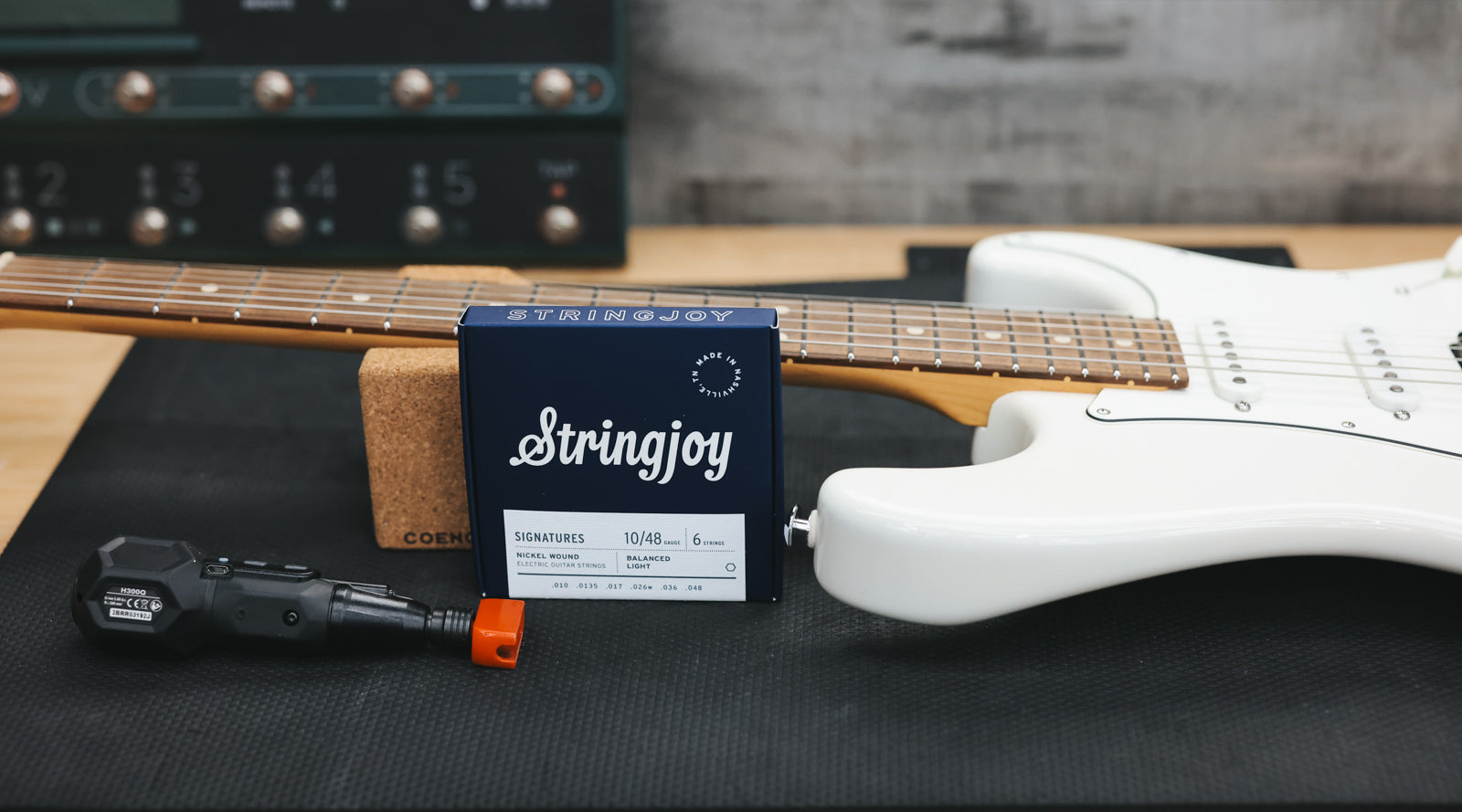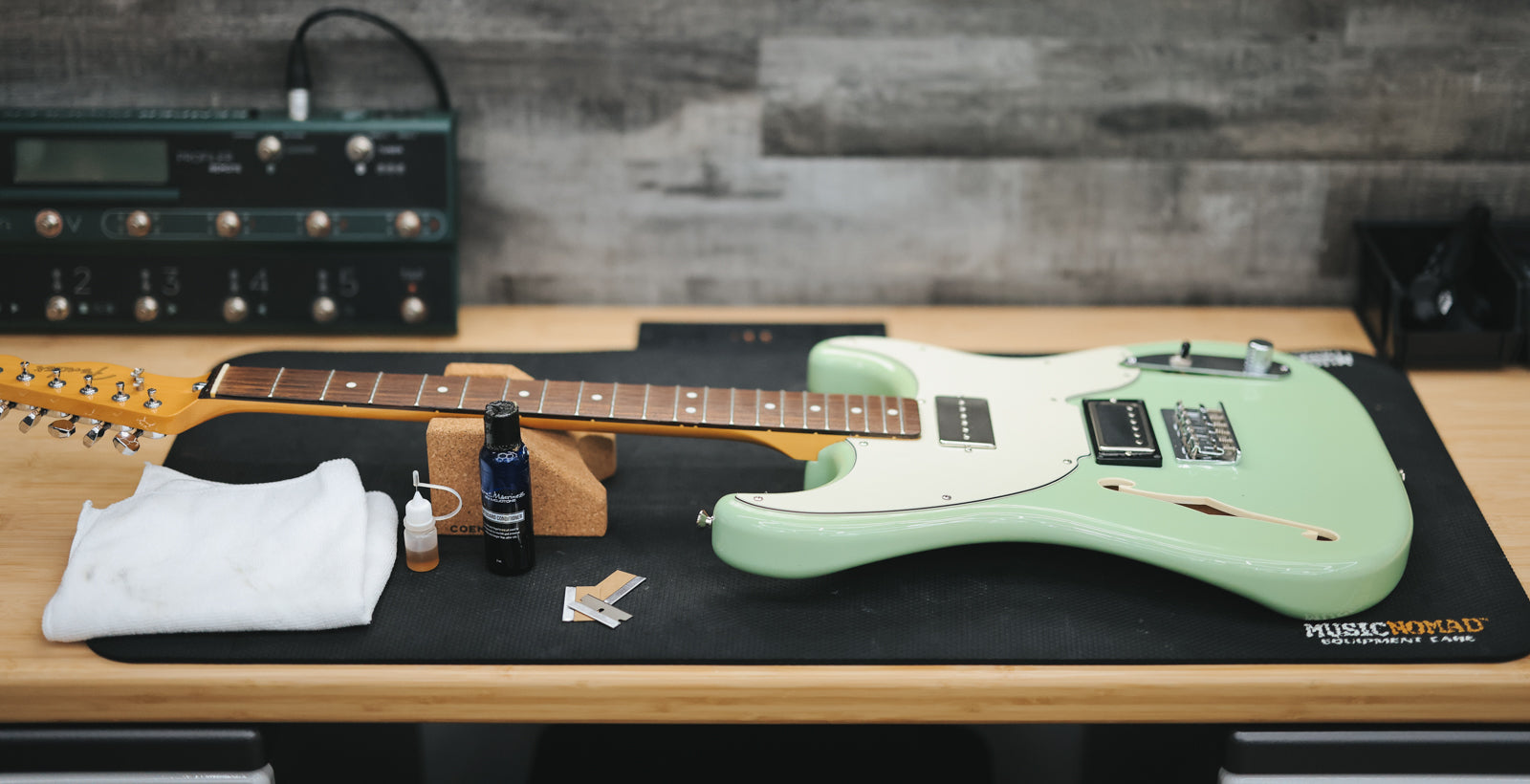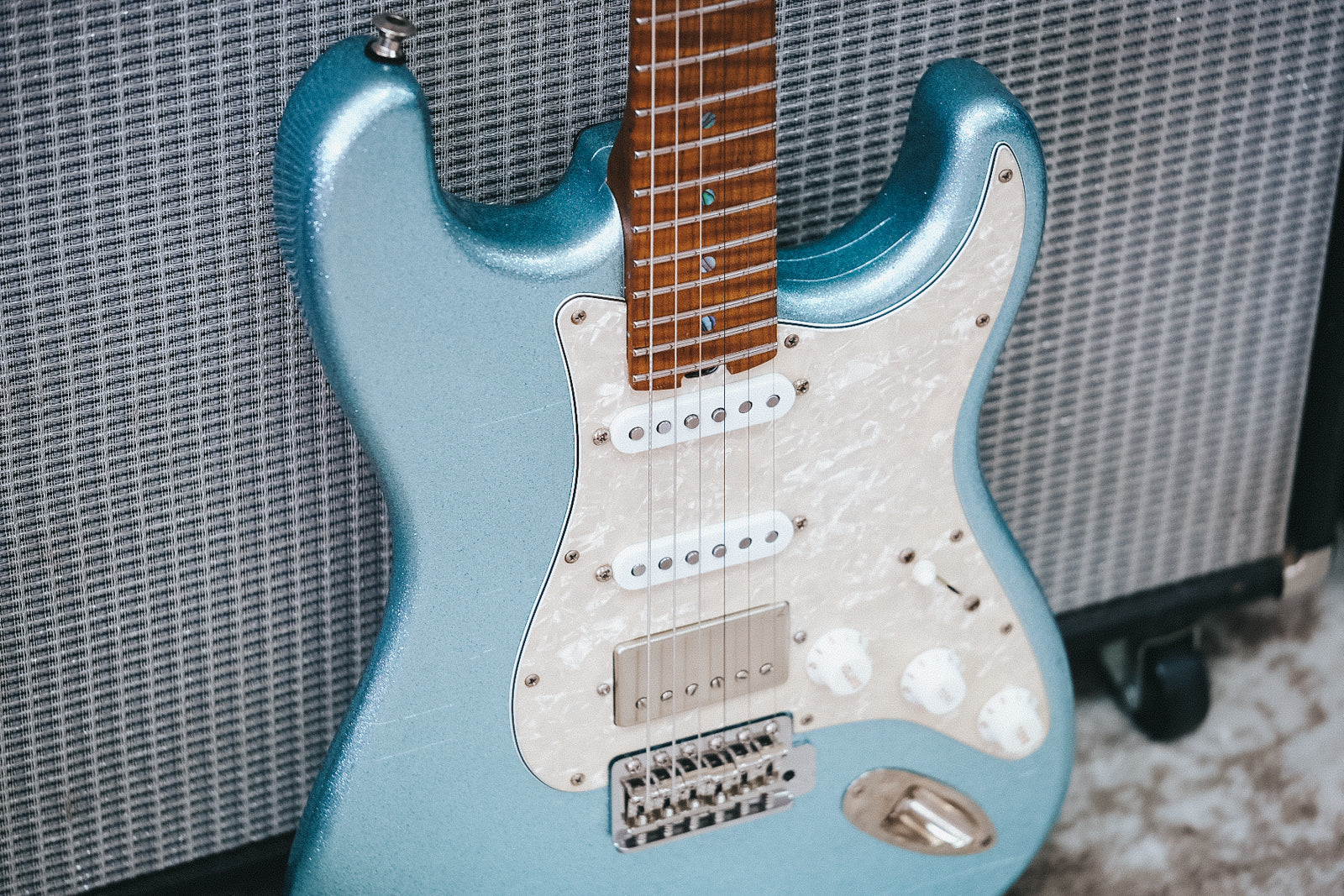
How to Change Guitar Strings On An Electric Guitar
Playing an electric guitar is what we love to do, right? As guitarists, we pour a lot of love into our instruments. Part of that love is basic guitar care and maintenance. One major key to keeping your guitar sounding and playing its best is taking care of the strings. Fresh strings mean better tone, more stable tuning, and a smoother feel under your fingers. Changing electric guitar strings is actually a pretty straightforward process, but it can seem confusing for beginners. I remember being unsure of how to do it myself when I started out playing guitar. I hadn't changed my strings in months before my guitar teacher realized my strings were dark and crusty, and showed me how to do it right. This process isn’t difficult, but it is important, and changing strings is a routine task every guitar player should learn to master.
If you’re new to the electric guitar, or even if you’ve been playing a while but have always had someone else change your strings, this guide is for you. Today, I’m sharing a step-by-step guide on how to change guitar strings on an electric guitar. By the end, you’ll see that giving your guitar a fresh set of strings is totally doable, and your guitar tone and wallet will thank you as a result.

How to Change Guitar Strings On An Electric Guitar
In this post, I’m going to walk you through everything you need to know (and what you can expect) when changing your electric guitar’s strings. We’ll start by answering a common question: do you really need to change your guitar strings? Then, we’ll dive into a step-by-step tutorial on removing the old strings and putting on new ones, with plenty of tips to make it easy. I’ll also talk about how often you should swap out strings to keep your guitar in tip-top shape. Whether you just bought your first electric or you’ve been rocking for years, I hope you’ll pick up some useful pointers here. This guide is helpful for total beginners and long-time players alike.
(By the way, if you’re a brand new guitarist still shopping for gear, you might also want to check out our post on what is a good electric guitar for beginners. Starting with the right guitar will make your journey that much more enjoyable!)
Alright, let’s dive in and get those strings changed!
Do You Need to Change Guitar Strings On An Electric Guitar?
You might be wondering, “Do I really need to change my guitar strings?” Especially if you’re new to guitar, it’s a fair question, after all, strings don’t get a lot of attention until one breaks. The short answer is yes: changing your strings periodically is important maintenance for any guitar. Even if your strings haven’t snapped, they gradually wear out and affect your guitar’s sound and feel. Here are some big reasons why you should be removing the strings and swapping in a fresh set every now and then:
-
Better Tone and Sound Quality: Over time, strings accumulate dirt, sweat, and oils from your fingers, and the metal begins to oxidize. This build-up dampens the strings’ vibrations and your electric guitar starts to sound dull or flat. You’ll lose that crisp, bright guitar tone you had when the strings were new. A fresh set of strings will restore clarity, brightness, and sustain to your sound. New strings = better tone, plain and simple.
-
Improved Tuning Stability: Old strings tend to slip out of tune more easily. As strings wear, they develop kinks and weak spots that make it hard for them to hold tension. You might find after you tune up, play a few notes, and then the guitar is flat again! Even worse, aging strings can mess with your intonation (so notes up the neck don’t play quite in tune). By putting on new strings (and stretching them properly, as we’ll cover), your guitar will stay in tune more reliably. You’ll spend less time tuning and more time playing, which is a win in my book.
-
Fewer Broken Strings: String snapping mid-song is a real mood killer for everyone. 😬 Old strings are much more prone to breaking. Metal fatigues with use: bending notes, strumming chords, exposure to sweat, dirt, and humidity – all of that weakens the string over time. If you’ve ever had an ancient string suddenly pop, you know it tends to happen at the worst time. Regularly changing strings greatly reduces the chance of breakage. It’s cheap insurance for performances and practice sessions. (And if you do break a string on a relatively fresh set, you can just replace that one string. But if a lone new string is paired with a bunch of dead old ones, it’ll stick out in sound and feel. Best to change the whole set when strings are past their prime.)
-
Better Feel and Playability: Old strings feel gross as well. They get corroded and grimy, which makes them rough on your fingers. Ever run your hand down the neck and feel scratchy crud under your fingertips? Yuck. 😝New strings, on the other hand, feel smooth as butter. Your fingers glide more easily, bends and slides take less effort, and you’ll likely hear less finger squeak. Fresh strings also have a nice flexible playability to them, whereas heavily worn strings can feel stiff as high-tension wires.
Overall, changing your strings is part of loving and caring for your instrument. It’s amazing how a simple string swap can breathe new life into your guitar. I’ve seen guitars come into my shop with strings that are literally crusty and discolored – trust me, that’s not a good look (for your fingers or your tone). Putting on a fresh set not only makes the guitar sound better, it can make it look cleaner and inspire you to play more.

How To Change Electric Guitar Strings
Alright! It is time to roll up our sleeves and change those strings! 🎸🔧 Don’t worry, I’ll break it down into simple steps. Once you do this a couple of times, it’ll become second nature. Before we begin, gather the tools and supplies you’ll need for an easy string-changing session:
-
A new set of strings. Make sure you have the correct type (electric guitar strings, of course) and your preferred gauge. Most electrics use nickel-plated steel strings. If you’re not sure what strings to get 10’s, a standard 10-46 set (0.010–0.046 gauge) is a common choice for many guitars, or 9-42 for a lighter, easier bend feel. It’s always good to have an extra set of strings or two on hand in case you break one or for your next change.
-
String winder (optional). This is a small crank tool that fits over a tuning peg. It lets you wind/unwind strings much faster. It’s not strictly necessary, but it will save you some time (and wrist fatigue). If you don’t have one, no worries, you can twist the tuners by hand.
-
Wire cutters: You’ll use these to cut the strings. Cutting off the excess string ends after installing new strings makes your guitar look neat and safe (no pokey ends to stab your fingers). You can also use them to snip off old strings for quick removal. A basic pair of diagonal cutters from a hardware store works fine.

-
Tuner: After putting on the new strings, you’ll need to tune the guitar back up. An electronic tuner or tuning app is handy to get each string to pitch.
-
A cloth and guitar cleaner (optional but recommended): With the strings off, it’s the perfect time to clean your guitar a bit – especially the fretboard. Grab a soft cloth (an old cotton T-shirt or a microfiber cloth works great). You might also use a specialized guitar cleaning solution or simply a few drops of lemon oil if you have an unfinished fretboard (like rosewood or ebony). We go over how to clean your fretboard in detail in this post about how to clean guitar fretboard here!
-
A stable workspace: You’ll want a place to lay the guitar flat while you work. A kitchen table or desk is fine, but put down a thick towel, cloth, or foam pad to protect the guitar’s finish. If you have a guitar neck rest (or even a folded towel) to support the neck, even better. This just keeps the guitar from sliding around.

Step 1: Remove the Old Strings
First things first, lets get these old strings off your guitar. There are a couple of ways to go about removing the strings, and different players have different preferences. I’ll share my prefered method that’s safe and easy for electric guitars:
Loosen each string by detuning it: Start with the low E (the thickest string) or high E (thinnest string), it doesn’t really matter which end you begin with. Turn the tuning peg down, lowering the tension. If using a tool and in doubt of the correct direction, pluck the string as you turn, you want the pitch to drop). Keep loosening until the string has almost no tension. Repeat this for each string, one by one, until all six strings are slack. This step is important because you don’t want to cut a string that’s at full tension, which could cause the string to snap violently (and possibly whack you or your guitar). So always loosen first.

Optional: remove vs. one at a time – Some people like to change strings one at a time (remove one old string, immediately replace it with a new one, then move to the next string). This method keeps a more consistent tension on the neck and bridge throughout the process. Other people (myself included) often take off all the old strings at once, especially on electric guitars, to allow for easy cleaning. Good news: taking all the strings off will not harm your guitar, as long as you don’t leave it that way for weeks. The neck can handle the temporary release of tension (think of it as your guitar doing yoga – it will stretch back when the new strings are in place). For electric guitars, it’s perfectly fine to remove all at once, and it makes it easier to clean the fretboard. If you have a floating bridge or tremolo (like a Floyd Rose system), changing one at a time might be easier to maintain tension balance, but that’s a more advanced scenario.
Now, remove the strings from the guitar: Once your strings are loose, grab those wire cutters and cut each string around the midpoint of the neck. I do this so I have enough string to grab with my hand and pull through the tuning peg (if there are multiple wraps on it), but the biggest reason is to prevent a sharp end from sitting around your shiny pickup cover(s), which can cause scratches. If you do this frequently, slip a paper towel or thin cloth under the strings and lay it across your pickup covers before cutting the strings; that way, you won’t have this issue to worry about.

On a typical electric guitar (like a Stratocaster, Telecaster, etc.), the strings either feed through the body (you’ll see the ball ends come out the back of the guitar) or through a tailpiece/bridge. Gently push the string’s cut end out toward the bridge, and you’ll notice the string's ball end feeding loose on the back side of the guitar body. If you have a bridge tailpiece, be mindful that without string tension, that bridge will come loose on its pins, and you can either tape it in place or just remove it entirely from the guitar body, taking the half-length cut strings with it.
At this point, you should have all the old strings off the guitar. The scary part is done! Let's grab our new strings and get back to making tones again, shall we?

Step 2: Clean the Fretboard (and Guitar) Before Installing New Strings
Just kidding! Let’s not waste a good opportunity to spiff up the ‘ol axe ay?? With the strings off, take a moment to appreciate how easy it is to access the fretboard now. Then to a follow our guide on how to clean a guitar fretboard here before proceeding. If your fretboard is looking good already, simply move on to step 3!

Step 3: Install the New Strings (One by One)
Now for the main event: putting on the fresh strings. 🎉 We’ll go string by string. It doesn’t matter which end you start (low E or high E) – though I personally like to start with the low E and work my way to the high E. Here’s the step-by-step for each string:
-
Unpack and identify the strings: Guitar string packs usually have each string in an individual envelope or they might be color-coded at the ball-ends. The gauges (thickness) go from thickest (low E) to thinnest (high E). Typical electric guitar string sets in standard tuning are: 6th string Low E (.046), 5th A (.036), 4th D (.026), 3rd G (.016 or .017), 2nd B (.011), 1st high E (.009 or .010). Check the packaging to know which is which if they aren’t labeled, you don’t want to accidentally put the wrong string in the wrong spot. Most packs are labeled by note or number. My cheat code is to start with the thickest string (low E) and work my way forward from the individual string envelopes.
-
Insert the new string at the bridge: Take your low E string (the thick one) first. On most electric guitars, you’ll feed the string’s ball end through the bridge or body from the back. For example, Strat-style guitars have holes in the back; the string goes in from the backside and comes out through the bridge on top, as pictured above. A Les Paul or similar might have a separate tailpiece, in that case, feed the string through the tailpiece hole. Either way, get that ball end seated in its place and pull the string up along the fretboard and towards the headstock.

-
Secure the string to the tuning post: Now thread the plain end of the string through the hole in the appropriate tuning post on the headstock. Pull it through until the ball-end is snug at the bridge and the string is relatively straight. Leave some slack for winding around the post – this part is key to ensure you have enough wraps to secure the string, but not so much that it’s messy. A good rule of thumb is to pull the string through tight, then back it off by about 2-3 inches of slack (for the thick strings, a bit less slack; for thinner strings, a bit more because they’ll wrap more). My cheat code here is to pull the string tight, hold it taut on the backside of the tuning post with my left hand, and slip my right hand between the string and the 12th fret, which creates “space” and the correct length for an appropriate # of wraps.

If you have a “safety post” where the string doesn’t go “through” the post but pokes in through the top, you need to cut the string length before inserting. You can measure that necessary slack by spans of tuning pegs: for example, pull the low E string taut, then cut it two tuning post distances longer, i.e. cut the low E string at the D post. Cut the G string at the high e post, and so on. It doesn’t have to be perfect, but you need enough length to get a minimum of 2 full wraps for maximum stability. Too much slack isn’t “bad”, but you’ll be winding a million loops and it looks untidy.


Begin winding the tuner and keep the string in place: If you have a pass-through style tuning post, bend the string 90 degrees out and away from the headstock. This will help hold the string in place as you start to tension the string and create its first wrap. If you have a safety post, there’s a slot that you can bend the string through at a 90 degree angle. Important tip: We are doing an over/under method for the pass-through post for maximum stability, so the first wrap is important. The safety post is slightly simpler. For the pass-through style, guide the string with your free hand so that the first wrap of the string lies above the bent string and rotate the peg 360 degrees.


At this point, it’s important that every wrap goes under the previous wrap(s) on the post. This helps lock the string in and ensures a good angle over the nut. Typically, you’ll get 2-5 wraps around the post. The thick low strings will have fewer wraps (2-3) and the thin high strings might have 5 or so, which is fine. Keep tension on the string with your hand as you wind so it wraps tightly. For the safety post, simply guide the string to follow under each previous wrap - no need to cross over. Using your string winder here makes it quicker – just crank until the string starts to have tension.
-
Tune up to pitch (roughly): As you wind, the string’s pitch will start coming up. Use your tuner to get the string loosely up to its approximate correct note (don’t worry if it drops, because these new strings will stretch). For now, get the low E somewhere in the E ballpark.
-
Repeat for the other strings: Move to the A string next, and so on. The process is the same: feed the string through the bridge, pull it through the tuner post (or insert it into the safety top), leave enough slack, and wind it up! One thing to watch: on 3-per-side headstocks (like a Gibson or PRS style), the tuning direction is reversed on the other side. Just always make sure you’re winding so that the string goes toward the center of the headstock and down. If it feels confusing, note how the old strings were, and after one or two strings it will click and you’ll never forget. Fit check: Make sure the string sits in its proper nut slot as you tighten it along with the bridge saddle - if the string is sitting against the wrong component, it could scratch something or create a tiny abrasion on the string, which could create a weak point for it to break under tension later.


After all six new strings are on and roughly tuned, your guitar has strings again, let’s go! But we’re not done yet. New strings tend to go out of tune quickly until they are properly stretched and settled. So there are a couple more critical steps to ensure your restringing job is truly complete.

Step 4: Stretch and Tune the Strings
If you’ve ever put new strings on and then found the guitar constantly slipping out of tune for the next day or two, it’s because fresh strings need to be stretched. When strings are brand new, they have a bit of elasticity and will continue to stretch under tension, causing the pitch to drop until they settle in. We can expedite this settling process by manually stretching them.
How to stretch your strings: With the guitar tuned to pitch, place it in your lap and use your picking hand to gently tug each string upward toward your body a few times. I typically pull from between the pickups on a humbucker guitar, or around the location of the middle pickup if it has one and pull it up about ½-3/4 inch and release. You can do this along a few points of the string’s length (12th fret, around 7th fret, etc.). You’re not trying to yank the strings like a bow and arrow, just give them a firm pull. You might hear some creaking as the winds on the tuning post tighten, and that’s okay. After stretching, the string will now be flat (lower in pitch). Retune it to pitch. Repeat this cycle maybe 2 times per string, and each time you’ll notice that the string goes out of tune a little less. After a couple stretches, it should stay nearly in tune after you pull on it. That’s when you know the string has settled.

Do this for all six strings. It’s a bit tedious but absolutely worth it and your guitar will hold tuning much better right away. Skipping the stretch can mean your guitar keeps drifting flat as you play, which is not professional. So don’t skip this step!
By the end of this process, all strings should be on, stretched, and tuned to pitch. Strum an open chord and listen to it ring out nicely with that beautiful chime of the new strings.

Step 5: Cut Off the Excess String Ends
Last step: let’s tidy up those sharp, floppy ends sticking out of the tuning posts (you can skip this step if you have safety posts, cause your strings are already trimmed). Take your wire cutters and trim the excess string close to each post. Be careful as you snip, the cut-off ends can launch off the bench, and finding them can be tricky. I like to hold the piece that’s about to be cut so it doesn’t shoot across the room (or into my eye).
Your electric guitar now has a shiny new set of strings on it, all cleaned up and ready to rock. 🎸🔥

Quick recap of the string-changing tips: Always loosen the old strings before removing or cutting them, and take the opportunity to clean the fretboard if needed. Feed and wind the new strings with the right amount of slack and neat wraps on the tuning posts, stretch them out, and clip off the excess. Follow these steps and you’ll have a perfectly strung-up instrument every time. But how often should you be doing this? Luckily, we have a full blog post about just that! Go ahead and check out that post here. TL;DR: Every 3 months for a regularly played instrument at MINIMUM.
If you want to learn more about your guitar strings, read our post "What Are Guitar Strings Made Of."



Leave a comment
This site is protected by hCaptcha and the hCaptcha Privacy Policy and Terms of Service apply.